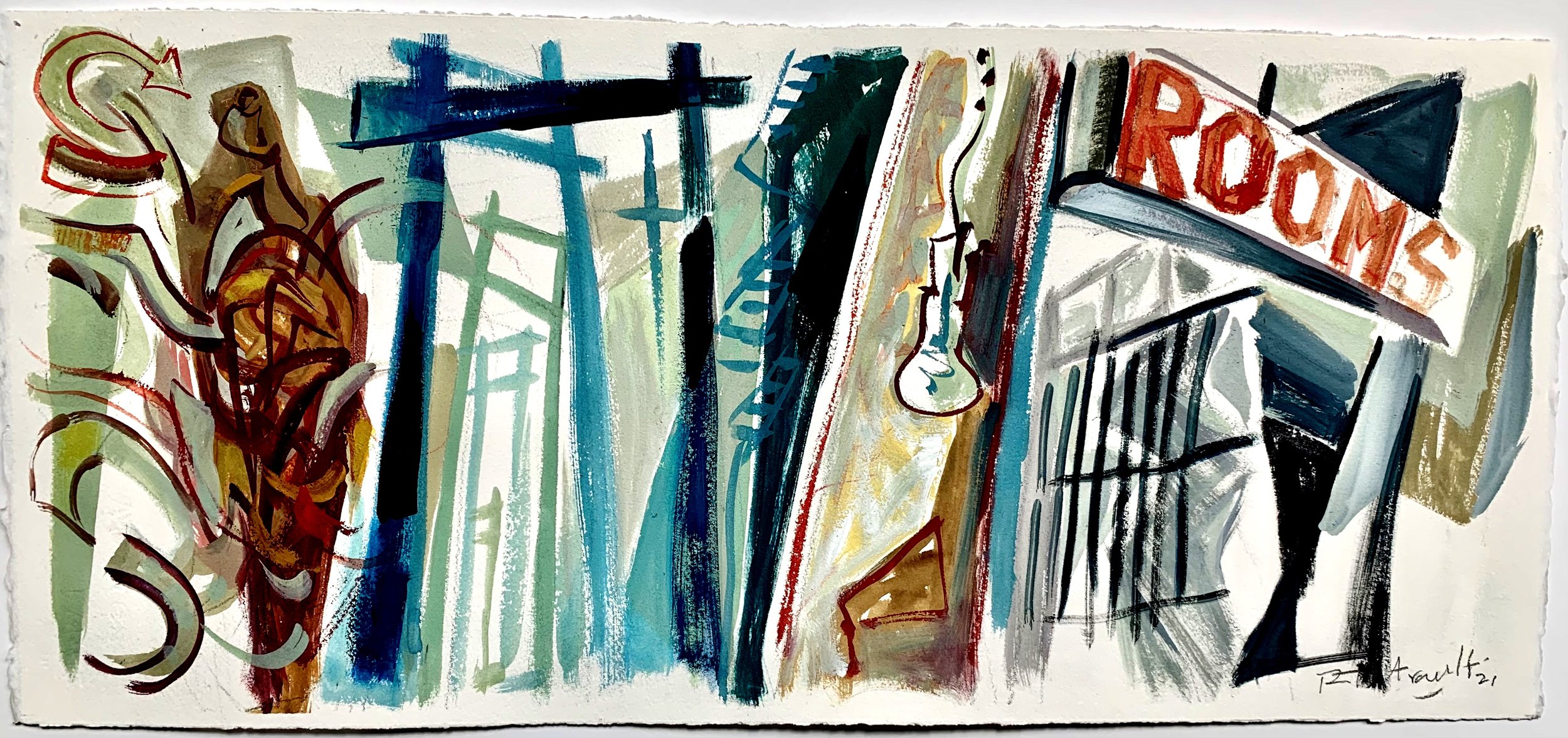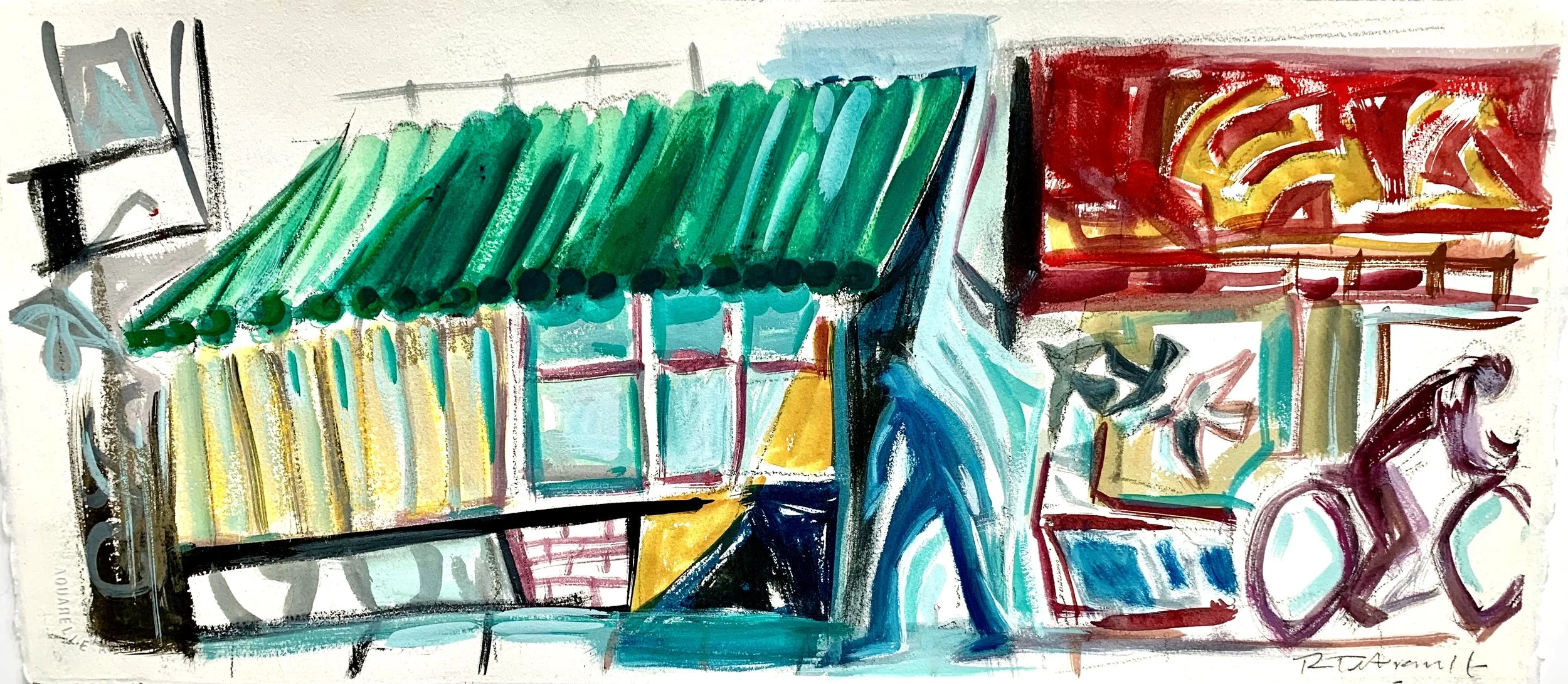Eastside Culture Crawl opens studios for 25th anniversary, with a wave of new work
Organizers expand both mandate and event dates, while artists reflect on the themes of our times
Richard Tetrault has had one of his most productive years. Photo by Esther Rausenberg
Binner #1, part of Richard Tetrault’s “25 Pieces for 25 Years”.
Graffiti #1, part of Richard Tetrault’s “25 Pieces for 25 Years”.
Chinatown Nightscape #2, part of Richard Tetrault’s “25 Pieces for 25 Years”.
The Eastside Culture Crawl takes place via prebooked visits November 12 to 14 and open studios November 18 to 21
THE PAST YEAR and a half has given Vancouverites a chance to see their surroundings in new ways—to attune themselves to the subtle shifts in the city over the day. Travel bans and indoor-gathering restrictions will do that to you.
Richard Tetrault has captured those ever-changing moods for much of his career, painting and drawing en plein air, often in the Downtown Eastside and Chinatown near his studio. But never more so, perhaps, than in a new series he’s created to mark the 25th anniversary of the Eastside Culture Crawl. Called “25 Pieces for 25 Years”, the gestural gouache-on-paper paintings capture images like a bicycle blurring by lit awnings and glowing store windows in nighttime Chinatown; a binner searching in the shadows of abstracted office towers; and graffiti spreading across walls by a neon-red “ROOMS” sign.
“It’s probably been the most productive year I’ve had—almost ever, because I’m in the studio all the time,” says Tetrault, who normally is out working more on community-art and mural projects. “These are all quite small, taken from the immediate environment but also a synthesis of landscape—urban and rural. I decided to do 25—one for each year of the Crawl. There’s a touch of Chinatown, of the harbourfront—they’re framed and they’ll fill up a whole wall at my studio on the Crawl.”
Tetrault’s project is not just a vivid reminder of how many years the Eastside Culture Crawl has been inviting art lovers into the neighbourhood, but of the fact that many of its 400-plus artists showing this year have been very, very busy during the pandemic.
Visitors will finally have the chance to see how their work has evolved when the massive open-studio event returns to a full live, in-person format this year, after having to pivot to a virtual and limited in-person event in 2020.
It’s taken a considerable amount of work for the Crawl team, but the visiting options spread over two full weekends this year: November 12 to 14, those less comfortable with crowds can prebook individual visits; then, November 18 to 21, the district’s studios swing open their doors to vaccinated, masked public drop-ins for the first time since 2019 (when it attracted a peak 40,000 people).
“For people to come to see the art in person and talk to the artists is really what gives the event its meaning,” explains the Crawl artistic and executive director Esther Rausenberg, sharing a line with her longtime partner Tetrault. “It’s really difficult to have that online. You have to have that direct connection with the art.”
Behind the scenes, the Crawl expanded its role this year—coming a long way from its humble beginnings over the last quarter century.
Just three studios—Parker Street Studios, Paneficio Studios, and Glass Onion Studios—joined forces to hold the first Crawl in 1997. Rausenberg helped organize, and Tetrault can take credit for giving the event its name. At the time, they were thrilled to see 1,000 people turn out.
“When we started it 25 years ago, I don't think anyone thought it'd last more than a few years,” Tetrault reflects. “Really it’s because of the public interest in seeing art in the location where it’s made: that kept the momentum going to where it is now. Artists will always keep producing, but the event itself was dependent on the enthusiasm of the public.”
Eastside Culture Crawl artistic and executive director Esther Rausenberg. Photo by Adam P.W. Smith
Tetrault attributes the success not just to the buzz of a festival, but to the equitable nature of it—free admission for one and all, beyond just art collectors. And there’s an educational draw, too, he adds, particularly for young people.
“One side of me is very keen on demonstrating how a wood print is made,” he says. “My favourite moments happen in little pockets of people saying, ‘Oh that’s how that works: you get a mirror image.’”
The Eastside Culture Crawl has evolved into much more than a festival of open studios—especially over the past decade, as skyrocketing real-estate prices in Vancouver have caused the loss of artist studios in the Crawl district.
In 2019, the Eastside Culture Crawl Society released a report called City Without Art? No Net Loss, Plus! that found more than 400,000 square feet of artist space had been lost over the previous 10 years. Making matters worse, rental rates for those spaces had increased by 65 percent.
Recently, the team took that advocacy a step further, establishing the Eastside Arts Society, a year-round group that will help to establish a designated Eastside Arts District aimed at preserving and promoting the cultural output of the area, as well as organizing the annual Crawl. (The Vancouver Foundation has awarded the group $300,000 to use over three years to develop a strategic plan for the project.) In August 2021, the society also launched the CREATE! Arts Festival of hands-on art workshops for the community.
Rausenberg reports that the pandemic did not exactly press “pause” on the loss of artist spaces. June saw the closure of White Monkey Design (496 Prior Street), a City of Vancouver building that was home to 20 artists, and of the Old Foundry Building (1790 Vernon Drive)—home to 30 artists over 18,000 square feet.
“It housed sculptors and potters and artists that needed to be there because of the materials they were using—some of that work is rather messy and dirty and does require ventilation,” she says of the latter, industrial-style space. “We really are at a critical point.”
Coming through the pandemic, a lot of artists are hurting in other ways, Rausenberg adds. “We’re seeing that anecdotally,” she says. “There wasn't a recovery in regards to exhibitions lost—the workshops and the teaching lost.”
That makes the Eastside Culture Crawl all the more needed this year. And it’s important to Rausenberg and her team that they make it as celebratory as possible—within health regulations, of course.
“We want people to feel welcome and we want them to feel safe,” she stresses. “At Parker Street Studios, where there’s 200 artists, we’ll have food trucks outside, so it will still feel festive. And then we have our craft breweries, where you can go grab a pint if you have to wait to get into a building.”
In the studios themselves, you may see artists reflecting relatable pandemic experiences into their work in subtle ways. As Rausenberg puts it, “Some are asking the big kind of existential questions that many of us did not have time to ask before.”
In Tetrault’s studio, beyond his “25 Pieces for 25 Years” series, look for another series of paintings that depicts vessels submerged under West Coast waters, being overtaken by plants and other sea life.
“I guess it comes from feeling like I’ve been submerged for the last year of COVID, feeling somewhat secluded or cloistered,” Tetrault explains. “And then there’s the idea of the natural world becoming more dominant—it’s in people’s awareness again.”
So whether it’s street scenes or underwater scenes, Tetrault and other artists can help us all process this strange time that we’re going through, just as creating art helps them process it themselves. And of course, still others—through surreal assemblages, Zen-like pottery, serene landscapes, or wearable art—will simply help us escape reality while we lose ourselves in the Crawl.

















